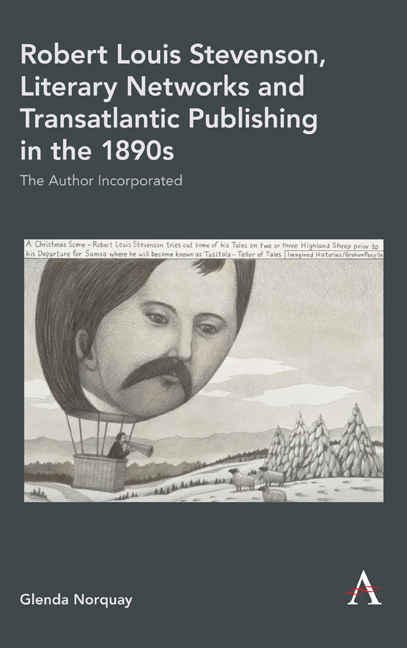 Robert Louis Stevenson, Literary Networks and Transatlantic Publishing in the 1890s
Robert Louis Stevenson, Literary Networks and Transatlantic Publishing in the 1890s Book contents
- Frontmatter
- Contents
- Acknowledgements
- Abbreviations
- Introduction
- 1 Lemuel Bangs: ‘The Senator’
- 2 A Tale of Two Texts
- 3 ‘A Gentleman Called Charles Baxter’
- 4 Sidney Colvin: Custodian and Monument
- 5 Family, Friends and Collaborators
- 6 Arthur Quiller-Couch: The Quivering Needle
- 7 Richard Le Gallienne: ‘Not While a Boy Still Whistles’
- Conclusion: Robert Louis Stevenson Incorporated
- References
- Index
Conclusion: Robert Louis Stevenson Incorporated
Published online by Cambridge University Press: 16 February 2020
- Frontmatter
- Contents
- Acknowledgements
- Abbreviations
- Introduction
- 1 Lemuel Bangs: ‘The Senator’
- 2 A Tale of Two Texts
- 3 ‘A Gentleman Called Charles Baxter’
- 4 Sidney Colvin: Custodian and Monument
- 5 Family, Friends and Collaborators
- 6 Arthur Quiller-Couch: The Quivering Needle
- 7 Richard Le Gallienne: ‘Not While a Boy Still Whistles’
- Conclusion: Robert Louis Stevenson Incorporated
- References
- Index
Summary
In the essay that led to his exchange with Richard Le Gallienne, Stevenson describes the pleasure of creativity for the writer who ‘sees his airy structure growing on the page’. Yet the immediate satisfaction of ‘a morning of successful work’ is mitigated because for those who make their way by professing to please, a day will come when it is hard to continue to delight: ‘the ardour shall have declined and the cunning shall be lost’ and the writer will be condemned to take on work he does not love. Even worse, ‘he must lie exposed to the gibes of the wreckers of the press, who earn a little bitter bread by the condemnation of trash which they have not read, and the praise of excellence which they cannot understand’. Stevenson thus delineated the pleasures and pressures of the literary marketplace. The fate he outlined with some bitterness was not to be his yet, as the disarray of Le Gallienne's last years demonstrates, tastes change.
After Stevenson's death, after battles over his literary life, and in spite of, or perhaps because of, the proliferation of memorials (written and material) to him, his critical standing suffered. In a perceptive dissection of ‘the dialectics of a reputation’, J. C. Furnas offers various reasons why (in the words of Edwin Muir) ‘Stevenson has simply fallen out of the procession’. Personality and the romance of Samoan life, he suggests, diverted attention from his work to the man. At the same time as the image of ‘RLS’ was thus consolidated, he argues, his body of work became fractured: individual essays were set for school study, fragments of his writing appeared in anthologies. Treasure Island encouraged his framing as a popular author and writer for children and then its origins were obscured by cinematic adaptation. In his analysis Furnas gestures towards some of the tensions articulated in this study. ‘RLS’ offered a powerful image of authorship: his perceived boyishness, unstable health, geographical distance, movement across continents and abandoning of literary responsibilities, all reinforced constructions of him as romantic figure, set apart from the everyday business of literary production. Those same factors, however, led to very different kinds of investments in him, producing diverse incorporations of the authorial body into various interests and demanding that a range of players took on parts of the authorial body in acts of literary prosthesis.
- Type
- Chapter
- Information
- Robert Louis Stevenson, Literary Networks and Transatlantic Publishing in the 1890sThe Author Incorporated, pp. 199 - 206Publisher: Anthem PressPrint publication year: 2020


